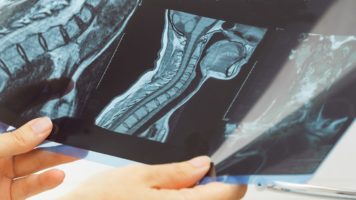Pain and suffering are harm you endure from an accident that may not have a specific dollar amount associated with it but has monetary value, nonetheless. Proving damages from pain and suffering is often difficult because of its intangible nature.
An experienced Cape Girardeau personal injury lawyer can help you prove your pain and suffering damages. Continue reading to learn more about how you can work with an accident attorney to prove your pain and suffering damages.
Examples of Pain and Suffering
Understanding what qualifies as pain and suffering can be tricky. Harms such as pain and suffering include non-economic losses. We will explain non-economic loss further below. An accident victim’s harm can include an economic loss, but that same injury can go further than just the economic loss. The continuing problems sometimes associated with the initial economic loss may amount to pain and suffering damages.
Some examples of pain and suffering damages include the following:
- Lost income is an example of economic loss. However, the stress of losing income is an example of underlying harm from losing time at work. The stress itself of dealing with financial loss is an example of pain and suffering.
- Nerve damage from an accident is a physical injury. It may be easy to prove that you suffered nerve damage from an accident. On the other hand, the effects of nerve damage may be hard for others to see. Perhaps you developed ticks or involuntary muscle spasms from the nerve damage you suffered. The tics and spasms cause you great embarrassment. The embarrassment has value, and you deserve compensation for that harm.
- If you suffered head trauma in an accident, you might be entitled to recover for the physical harm and the intangible harm associated with the injury. Suppose the head injury caused memory loss, made you suffer some change in your personality, or you now have a diminished cognitive ability. These damages are intangible, but you may be entitled to compensation for these losses.
- The accident may have caused mental distress. You may suffer from depression or anxiety. Your mental distress can develop into post-traumatic stress disorder. These are intangible damages that we can categorize as pain and suffering.
What Are Non-Economic Damages?

Accident victims are entitled to receive compensation for their harm for non-economic damages. Proving non-economic damages is challenging, but with the right accident attorney, you can put yourself in the best position to receive a complete recovery for your harm.
Evidence Used to Prove Pain and Suffering
Although pain and suffering damages are intangible, you will need tangible proof of your harm to recover money after an accident. Your accident attorney will want to collect and review any evidence of your harm, and you will work together to prove your damages. Examples of what evidence will help prove your damages include:
Medical Records
Reviewing your medical records may be one of your attorney’s top priorities. Your medical records tell the story of your injuries after an accident. It is important to comply with your doctor’s orders and complete the recommended treatment after an accident. Compliance with treatment is important because it will help improve your condition and it helps build your case.
Medical Bills
Although pain and suffering damages are non-economic, often economic damages help inform a judge, jury, or insurance company’s decision about compensation for pain and suffering damages. You must keep all your medical bills and give them to your accident attorney so they can review them. The amount of money you spend on medical treatment after an accident may correlate with the value of your pain and suffering claim.
Records of Mental Health Treatment
Pain and suffering damages include emotional trauma and mental anguish. Reviewing your psychiatric and other mental health treatment records can build your case to recover for pain and suffering damages. Your accident attorney may use the notes from your mental health care provider to understand the extent of your pain and suffering.
Pictures of Injuries
A picture is undoubtedly worth a thousand words. Having pictures of your injuries helps make your claim come to life for a judge or jury. Supplying a judge or jury with hard proof of the injuries that the accident caused may help persuade a judge or jury to increase the amount of a pain and suffering award.
Proof of Lost Income
You may be unable to work after an accident. There may be many reasons that you may lose time at work after an accident. Lost income can create stress and mental and emotional anguish. For many people across the country, missing one paycheck can mean a significant financial crisis. You deserve compensation for this loss. An accident attorney can help you build a case for a pain and suffering claim using your lost income as proof of the harm.
Testimony from Family, Friends, or Coworkers
Your friends, family, and coworkers are an excellent place to start for your accident attorney to gather information about how the accident affected your life. These people know you the best and interact with you the most, so they likely have the best point of view on how you may have changed since the accident. This testimony can persuade an insurance company to increase its settlement offer.
If your case goes to trial, testimony from family, friends, and coworkers may paint a picture for a judge or jury and increase your odds of a successful outcome.
Your Own Account of How Your Injuries Affect Your Life
Perhaps the best evidence of pain and suffering damages is your account. Your accident attorney may work with you on how you explain your story to the insurance company and, if your case goes to trial, the judge or jury.
How are Pain and Suffering Damages Calculated?
Because of the intangible nature of pain and suffering damages, calculating your loss can be challenging. The knowledge of an experienced accident attorney is helpful if you believe you have a claim for pain and suffering damages.
How Do Insurance Companies Calculate Pain and Suffering Damages?
You deserve to receive compensation for all your damages after an accident. Unfortunately, although you deserve compensation, that doesn’t mean the insurance company will happily hand over the money.
Unlike economic damages like medical bills or lost income, pain and suffering damages do not have a straightforward way to calculate a settlement amount. For that reason, insurance companies use a program called Colossus to assist in calculating pain and suffering damages.
Colossus is a computer software program that insurance companies use to determine a dollar amount for pain and suffering damages. Insurance companies began using Colossus in the early 1990s. The software program spread nationwide, with more than half of all insurance companies across the United States using the program for settlement offers. Colossus works by helping insurance adjusters compare your injuries and losses to prior similar claims to calculate a fair settlement offer.
With all this technology, the offer may still be inadequate. If an insurance company offers an unsatisfactory settlement amount, an accident attorney can help you pursue the claim and get the money you deserve after an accident.
How Do Accident Attorneys Calculate Pain and Suffering Damages?
Your accident attorney will want to have a plan for getting you the maximum compensation available, and part of their plan is having an idea about how much your pain and suffering claim is worth. Your attorney will work closely with you to learn how the accident affected your life.
Your attorney may ask you questions that will help them gauge the severity of your pain and suffering, how long your pain and suffering lasted (or if you are still suffering), and how your life has changed since your pain and suffering started. Speaking to you and reviewing the evidence described above will help your attorney conclude how much to settle for to compensate you fully for your pain and suffering claim.
Are Pain and Suffering Damages Capped?
As your case continues, you may wonder how much money you can collect for pain and suffering damages. Is the monetary recovery for pain and suffering damages capped? The answer depends on in which state you file your claim. Some states, like Tennessee, limit recovery for pain and suffering damages to $750,000. Other states like California generally do not have a limit for pain and suffering damages, except for malpractice cases. Your accident attorney will know the limit on pain and suffering damages for your state and will help you manage your expectations for recovery.
What Mistakes Do Accident Victims Make While Pursuing Pain and Suffering Damages?
There are some common mistakes that accident victims make. While their accident case is pending, these mistakes tend to negatively affect their claim, including their claim for pain and suffering damages. Examples of common mistakes that accident victims make during a pending case include:
Waiting Too Long to File a Claim
Each state has a deadline for filing a lawsuit called a statute of limitations. Complying with the statute of limitations is vital to your case. If you fail to file a claim within the appropriate statute of limitations, the court will not hear your case. There are different statutes of limitations based on the type of case. Your accident attorney will help ensure that a court does not dismiss your case for noncompliance with the statute of limitations.
Not Getting Medical Treatment Immediately after the Accident
It is essential to seek medical care immediately after the accident. You must prove that the accident caused your injuries, and the easiest way to connect your harm with the accident is to get medical attention quickly. Insurance companies tend to use an accident victim’s delay in getting medical treatment as evidence that they didn’t suffer a serious injury in the accident.
Losing Evidence
You must keep track of all the evidence in the case. That means that you must keep up with your medical records, medical bills, proof of lost income, pictures of physical injury and property damage, records of your mental health treatment, etc. You may also want to keep a daily diary of how you feel. A record of your mental state as you are healing and as the case proceeds may be helpful as you attempt to prove pain and suffering damages.
Not Following Doctor’s Orders
Following your doctor’s instructions can mean the difference between winning and losing your case. The insurance company will take any bone that you throw them to avoid paying out a claim. Remember that your doctor is a part of your team, and their recommendations are important. If you do not follow your doctor’s orders, you risk not healing correctly and leaving money on the table from your accident claim.
Accepting a Settlement Offer Before Your Injuries are Fully Treated
You should never accept a settlement offer before fully recovering from your injuries. During your treatment, your doctor may determine that you have reached maximum medical improvement (MMI). MMI status refers to your doctor’s conclusion that your condition is unlikely to improve in any meaningful way. Once you reach MMI, you should speak to your accident attorney about how much you should accept as a settlement offer.
Contact an Accident Attorney in Your Area Today

Personal Injury Attorney, Phillip J. Barkett
You deserve compensation for your pain and suffering damages. Just because others cannot see an injury does not mean it is not real or that it does not significantly affect your daily life. It can be challenging to prove unseen damages, so you must create a legal team to support you and protect your compensation rights. Call a Cape Girardeau personal injury lawyer in your area today to get started on your pain and suffering claim.



